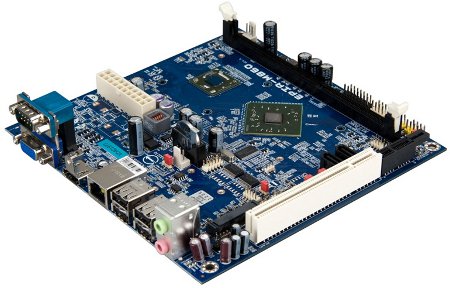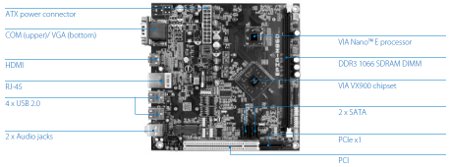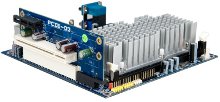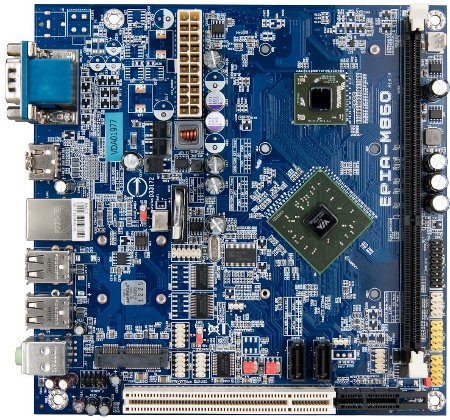Mini-ITX board targets HD signage, POS apps
May 17, 2011 — by Eric Brown — from the LinuxDevices Archive — 4 viewsVia Technologies announced a Mini-ITX board that features a 1.2GHz Via Nano E-Series processor and is aimed at signage and point of service (POS) applications. The Via Epia-M860 Mini-ITX board supports up to 4GB of DDR3 memory, and offers PCI, PCI Express, and Mini PCI Express expansion, as well as gigabit Ethernet, HDMI SATA, serial, and USB 2.0 connectivity.
The Via Epia-M860 is designed for demanding digital signage, media terminals, infotainment devices, and online streaming video, says Via Technologies. In addition, the board is said to be the first Epia board that supports Windows Embedded POSReady 7, presumably because it features two powered RS232 ports for POS peripherals.

Via Epia-M860
(Click to enlarge)

Epia-M860 detail
(Click to enlarge)

More Epia-M860 detail
(Click to enlarge)

Epia-M860 block diagram
(Click to enlarge)
Onboard connectors include dual SATA connections, two voltage-selectable (5V/12V) RS-232 pin headers, and dual USB pin-headers. There's also an SMBus header and digital I/O including GPI and GPO options, says the company.


Epia-M860 side view (left) and built-up version
(Click on either to enlarge)
- Processor — Via Nano E-Series clocked at 1.2GHz (fanless)
- Chipset — Via VX900
- Memory — up to 4GB of 1066MHz DDR3 RAM
- Expansion:
- Mini-PCI Express x4 (with USB)
- PCI Express x4 (with PCI)
- PCI (with PCI Express x1)
- Networking — gigabit Ethernet (rear panel)
- Other I/O:
- Rear panel:
- VGA
- RS-232 (selectable 5V/12V power)
- 4 x USB 2.0
- audio — mic in, line out
- HDMI
- Onboard headers:
- 3 x USB 2.0
- front audio
- PS/2
- 3 x RS232 (selectable 5V/12V power)
- SMBus
- front panel pin header
- 2 x SATA power
- ATX power
- sys and CPU fan connectors
- Rear panel:
- Operating temperature — 32 to 140 deg. F (0 to 60 deg. C)
- Dimensions — 6.7 x 6.7 inches (17 x 17cm); Mini-ITX
- Operating system — Linux, Windows 7, Windows Embedded Standard 7, Windows Embedded Standard/Compact, Windows XP, Windows POSReady 7

Epia-M860 from above
(Click to enlarge)
Availability
Samples of the Via Epia-M860 are available now, says Via Technologies. More information may be found at Via's Epia_M860 page.
This article was originally published on LinuxDevices.com and has been donated to the open source community by QuinStreet Inc. Please visit LinuxToday.com for up-to-date news and articles about Linux and open source.